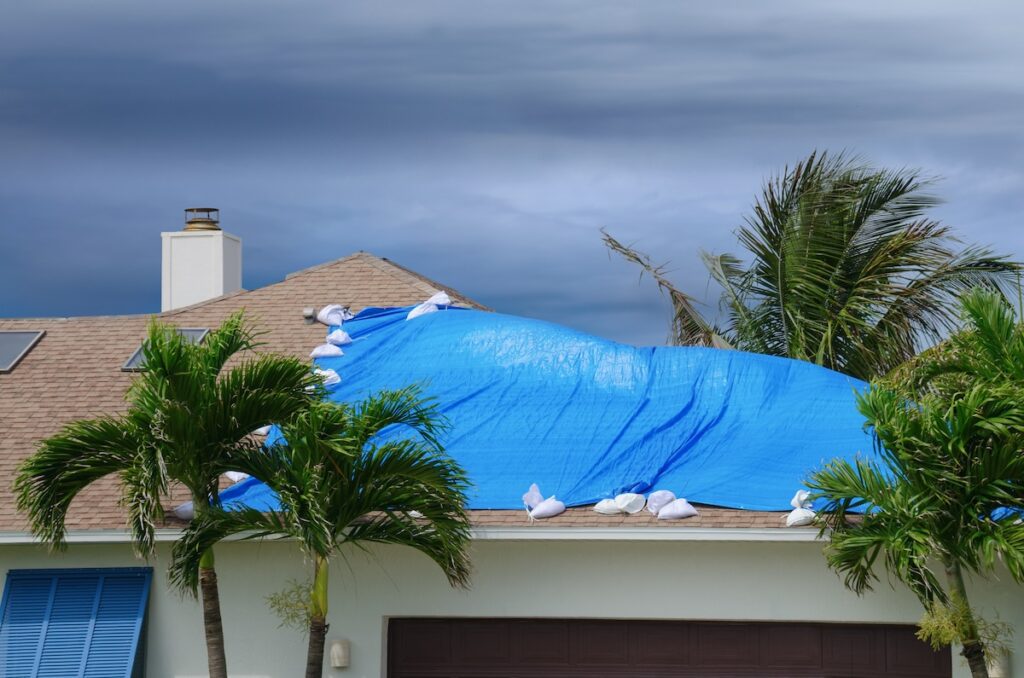Your roof can take a beating following a rainstorm, leaving it vulnerable to damages such as broken shingles and leaks. If your roof has weather damage after a storm, you need to put up roof tarping before any further water damage occurs.
Prevent mold and structural problems with the help of Same Day Restoration, the most trusted restoration company in San Diego and Orange County.
Roof Tarps & Potential Consequences
From leaks to mold, an exposed roof can lead to all sorts of issues. So what can happen when your roof remains uncovered? Here are some potential consequences of an uncovered roof:
Insulation Water Damage
Insulation is responsible for keeping your home insulated and comfortable. If your insulation is damaged by water, you might experience problems like musty air, cold areas, mold, wood rot, and poor indoor air quality. The weight of wet insulation could also lead to a full or partial ceiling collapse if it’s densely saturated.
Attic Water Damage
A roof that’s damaged and uncovered can cause a range of water damage in your attic. Everything from mold growth to wood rot can leave your home’s structure and air quality at risk, compromising the integrity of your living space.
Ceiling Water Damage
Leaks from an uncovered roof can seep through to your ceilings. This can lead to unsightly stains, a weakened structure, and a threat to the overall safety of your home.
Common Signs of Roof Water Damage
When it comes to roof water damage, there’s no one-size-fits-all. Water damage can happen due to cracked flashing, broken shingles, and clogged gutters. But what does water damage look like, and what are the telltale signs you should keep an eye out for?
Common signs include:
- Sagging areas on your ceilings
- Discolored spots
- Musty odors
- Visible leaks

Depending on the severity of the damage, Same Day Restoration can patch up everything from small leaks to roof replacements. Get in touch with a team member today.
How to Tarp a Roof
Tarping your roof is a temporary but effective solution until repairs can be made. Even though we urge you to contact a professional, tarping your roof is something you can do yourself—if you know what you’re doing. Check out these steps for proper roof tarping:
1. Identify the Damage
Identify the damage from afar. The last thing you want to do is scope out the damages while on your roof. Assess what you’re working with, and make sure roof tarping is safe to do before proceeding. If you notice any major leaks or holes, contact a professional.
2. Gather Materials
Next, gather the necessary materials needed for roof tarping. Materials include a thick and sturdy tarp, nails, a hammer, wooden boards, and a ladder. Again, only proceed if it’s safe and you’re confident in your roof-tarping abilities.
3. Secure the Tarp
Secure the tarp over the damaged section by anchoring it with your wooden boards. Then use your nails to fasten the tarp to your roof. Do this from corner to corner, ensuring it’s tightly fastened to prevent any water from seeping through.
4. Trim the Tarp
Once you’re done, trim the excess tarp for a perfect fit.
5. Call a Professional
If all of this sounds like too much of a hassle, call the professionals at Same Day Restoration. Our crew is experienced in handling roof tarp projects of all sizes, so we can save you the headache and keep you safe from any injuries.
Emergency Roof Tarp Services by Same Day Restoration
It’s best to tarp your roof before bad weather hits. That’s why Same Day Restoration offers expert roof tarping services around the clock, making sure your roof is protected from anything Mother Nature throws its way. Get started by contacting our crew—we promise to dispatch our technicians within 30 minutes of your call.
